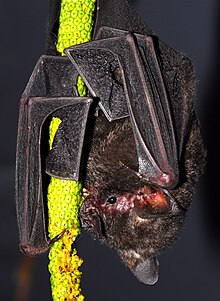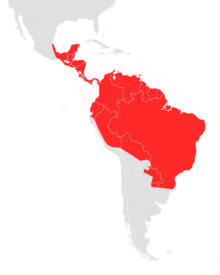Carollia perspicillata
| Seba's short-tailed bat | |
|---|---|
 |
|
| C perspicillata feeding on a Piper fruit | |
| Scientific classification | |
| Kingdom: | Animalia |
| Phylum: | Chordata |
| Class: | Mammalia |
| Order: | Chiroptera |
| Family: | Phyllostomidae |
| Genus: | Carollia |
| Species: | C. perspicillata |
| Binomial name | |
|
Carollia perspicillata (Linnaeus, 1758) |
|
 |
|
| Seba's short-tailed bat range | |
Seba's short-tailed bat (Carollia perspicillata) is a common and widespread bat species in the family Phyllostomidae. They are found in Central America, the northern parts of South America, and in the Antilles islands.
C. perspicillata is a small to medium-sized bat with relatively short ears, and a short, triangular noseleaf. They have fur that is dense and soft, and can be a variety of colors, ranging from black to brown to gray, with both albino and orange individuals found in certain areas.Sexual dimorphism varies in C. Perspicillata based on geography. In Colombia, there are no differences in size and color between sexes, but in the West Indies females are usually larger, and males are larger everywhere else this species is found.
C. perspicillata has a very good sense of smell, good visual acuity, and they show less specialization in their auditory apparatus as opposed to insectivorous bats. However, they still employ echolocation as a primary method of orientation. They use calls that originate in their mouths or nostrils, which are intense, and have been shown to be the most directional sonar beams in any species of echolocating bat.
C. perspicillata is primarily found in Mexico, Bolivia, Paraguay, Brazil, Trinidad, and Tobago. They are mostly found in forests, both deciduous and evergreen. It is usually found near stagnant water, in areas with a large amount of free internal space, usually below elevations of 1000 meters. As a result, this bat is among the most common that are caught at ground level, based on their foraging habits.
C. perspicillata is known to eat a large variety of fruit, as well as some flowers and insects. This bat is a generalist, eating a wide variety of fruits that are characterized by being high in protein and low in fiber. During times when fruit isn't plentiful, these bats supplement their diets using nectar and pollen from flowers, which also opens up the possibility for them being pollinators for the flowers they eat.
...
Wikipedia

